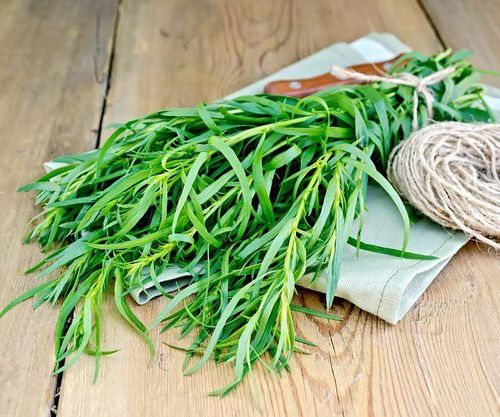Tarragon, also known as Artemisia dracunculus L., is an ancient herb that is related to the sunflower family. Tarragon is widely used for flavoring, aromatherapy, and medicinal purposes. It has a mild flavor that pairs well with dishes such as fish, beef, chicken, asparagus, eggs, and soups. Here are 8 benefits and uses of Tarragon.
1. Tarragon is packed with beneficial nutrients and low in calories and carbs
Tarragon is low in calories and carbs and packed with healthy nutrients. 2 grams of dried Tarragon equivalent to 1 tablespoon of dried Tarragon can provide (2):
- Calories: 5Carbs: 1 gram
- Manganese: 7% of the Reference Daily Intake (RDI)
- Iron: 3% of the RDI
- Potassium: 2% of the RDI
Manganese is an essential nutrient that plays an important role in brain health, body growth, improving metabolism, and reducing oxidative stress. Iron is an indispensable component for cell function and blood formation. Iron deficiency can cause anemia and lead to fatigue and weakness.
Potassium is a very important mineral for heart, muscle, and nervous system function. In addition, Potassium also has the effect of lowering blood pressure in patients with hypertension.
Although these nutrients are not high in Tarragon, this herb can still bring many health benefits when used.
2. Tarragon May Help Lower Blood Sugar by Improving Insulin Sensitivity

Insulin is a hormone that helps transport glucose into cells and use them for energy for the body's activities. Factors such as diet and inflammation in the body can lead to insulin resistance and increased glucose levels.
Tarragon may help increase the sensitivity of cells to insulin and increase their ability to use glucose. A study in diabetic animals showed that Tarragon extract reduced blood glucose levels by 20% compared to a placebo group.
Additionally, a 90-day, randomized, double-blind study looked at the effects of Tarragon on insulin sensitivity, insulin secretion, and glycemic control in people with impaired glucose tolerance. Patients given 1,000 mg of Tarragon before breakfast and dinner showed reduced insulin secretion, which may help keep blood sugar levels balanced throughout the day.
3. Tarragon May Improve Sleep
Inadequate sleep is associated with a number of poor health conditions and increases the risk of diseases such as type 2 diabetes and cardiovascular disease. Long work hours, job stress, or a busy lifestyle can contribute to poor sleep quality.
Sleeping pills are commonly used to help with sleep, but can lead to complications such as depression or addiction later on.
Herbs in the Artemisia family, including Tarragon, are used as a remedy to improve sleep quality. In a study in mice, Artemisia provided sedative and sleep-promoting effects. However, due to the small size of this study, more research is needed on the use of Tarragon for sleep - especially in humans.

4. Tarragon May Stimulate Appetite by Reducing Leptin Levels
Loss of appetite can be caused by a variety of factors, including age, depression, or chemotherapy. If left untreated, anorexia can lead to malnutrition and a reduced quality of life.
An imbalance of the hormones ghrelin and leptin can also cause anorexia. These hormones are important for maintaining energy balance. Ghrelin is considered the hunger hormone, while leptin is known as the satiety hormone. When ghrelin levels increase, it stimulates the brain, creating a feeling of hunger. Conversely, increased leptin levels cause feelings of fullness.
A study in mice investigated the role of tarragon extract in stimulating appetite. The results showed that tarragon reduced insulin and leptin levels, which helped increase body weight. These findings suggest that tarragon extract may help increase hunger.
5. Tarragon Helps Reduce Pain in Conditions Like Osteoarthritis
In traditional medicine, tarragon has been used to treat chronic pain. A 12-week study evaluated the effectiveness of a dietary supplement called Arthrem - containing tarragon extract - and its effects on pain and stiffness in 42 patients with osteoarthritis. Patients who took 150 mg of Arthrem twice daily showed significant improvements in pain symptoms compared to the placebo group.
6. Tarragon has antibacterial properties and prevents foodborne diseases
Today, food companies are using more additives to preserve food for a long time and extend its shelf life. Because of the health effects of chemical food preservatives, the current trend of using natural additives is becoming more popular. Plant essential oils are one of the alternatives.
Additives are added to foods to help add texture, prevent separation, preserve food and inhibit foodborne pathogens such as E. coli.
A study evaluated the effect of Tarragon essential oil on Staphylococcus aureus and E. coli - two types of foodborne pathogens. In this study, Iranian white cheese was treated with 15 - 1,500g / ml of Tarragon essential oil.
The results showed that all samples treated with Tarragon essential oil had an antibacterial effect on the two strains of bacteria compared to the placebo. The researchers concluded that Tarragon may be an effective preservative in foods.
7. Tarragon is easy to use and incorporate into food preparation

- Because Tarragon has a mild flavor, it can be used in many dishes. Here are some simple ways to incorporate
- Tarragon into your daily diet.
- Add to fried or scrambled eggs.
- Garnish on grilled chicken.
- Add to sauces, such as pesto or aioli.
- Incorporate into fish dishes such as salmon or tuna.
- Mix with olive oil to roast with vegetables
Tarragon comes in three different varieties - French, Russian, and Spanish. French Tarragon is the most widely known and commonly used in cooking. Russian Tarragon has a milder flavor than French Tarragon and loses its flavor when cooked, so it is best used immediately. Spanish Tarragon has a stronger flavor than Russian Tarragon but is milder than French Tarragon. It is often used for medicinal purposes. Fresh Tarragon is usually available in the spring and summer in cooler climates. It is not as readily available as other herbs, so you may only find it in large grocery stores or farmers markets.
8. Other Uses of Tarragon
Tarragon also has many other health benefits, but these benefits have not been widely studied.
May benefit heart health: Tarragon is often used in the heart-healthy Mediterranean diet. The health benefits of this diet are not only related to the food source, but also to the herbs and spices used in the dish.
May Reduce Inflammation: Cytokines are proteins that may play a role in inflammation. One study in mice showed a significant reduction in cytokine levels after taking a Tarragon extract for 21 days.
9. How to Store Tarragon
Fresh tarragon is best stored in the refrigerator. Simply rinse the stems and leaves in cold water, wrap them in a damp paper towel, and place them in a plastic bag. This method helps the herb retain moisture. Fresh tarragon will typically last four to five days in the refrigerator. Once the leaves begin to turn brown, they should be discarded.
Dried tarragon can be stored in a cool, dark, airtight container for up to four to six months.
Tarragon has many health benefits, including the ability to reduce blood sugar, inflammation, and pain, as well as improve sleep, appetite, and heart health. Additionally, it is versatile and can be used in a variety of foods.
For any questions that need to be answered by a specialist, as well as customers who need examination and treatment at Vinmec International General Hospital, you can contact Vinmec Healthcare System nationwide or register online HERE. Source: healthline.com
To arrange an appointment, please call HOTLINE or make your reservation directly HERE. You may also download the MyVinmec app to schedule appointments faster and manage your reservations more conveniently.








